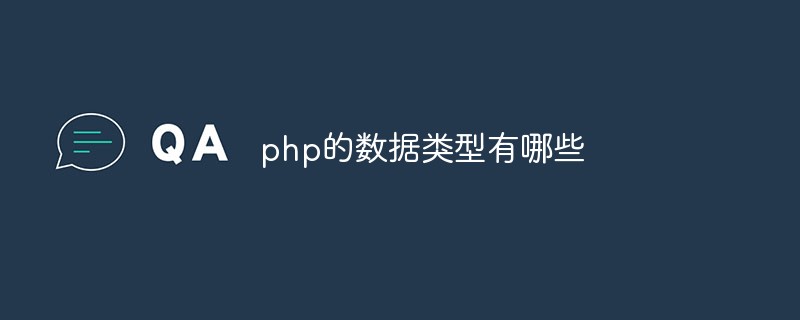
The data types of php are: 1. String type; 2. Integer type; 3. Float and Double floating point types; 4. Boolean type; 5. Array array; 6. Object object; 7. NULL empty value, etc.

#Data type defines the type of data that a variable can store. PHP allows eight different types of data types, the first five are called simple data types and the last three are composite data types. The following article will introduce you to the 8 data types of PHP. I hope it will be helpful to you.
Recommended: "PHP Video Tutorial"
1. Integer type (Integer)
Integer type only Contains whole numbers, both positive and negative, that is, numbers without a decimal part or decimal point. They can be decimal (base 10), octal (base 8) or hexadecimal (base 16). The default base is decimal (base 10). Octal integers can be declared with leading 0, and hexadecimal integers can be declared with leading 0x. The integer range must be between -2^31 and 2^31.
Example:
<?php // 十进制整数 $deci1 = 50; $deci2 = 654; // 八进制整数 $octal1 = 07; //十六进制 $octal = 0x45; $sum = $deci1 + $deci2; echo $sum; ?>
Output:
704
2. Floating point type (Double or float)
Yes Holds numbers that contain decimals or decimal parts, including positive and negative numbers. By default, the variable adds the smallest number of decimal places.
Example:
<?php $val1 = 50.85; $val2 = 654.26; $sum = $val1 + $val2; echo $sum; ?>
Output:
705.11
3. String (String)
Save any letters, Including even numbers. These are written in double quotes during declaration. Strings can also be written in single quotes, but will be handled differently when printing variables. To clarify this, take a look at the example below.
Example:
<?php
header("content-type:text/html;charset=utf-8");
$name = "欧阳克";
echo "我的名字是 $name \n";
echo '我的名字是 $name';
?>Output:
我的名字是 欧阳克 我的名字是 $name
4. Null value (NULL)
These are special types A variable can only contain one value, which is NULL. We write in uppercase letters by convention, but be case-sensitive.
Example:
<?php $nm = NULL; echo $nm; // 这将不会给出任何输出 ?>
5. Boolean
Contains only two values, TRUE or FALSE. Successful events will return true, unsuccessful events will return false. In Boolean values, NULL type values are also considered false. In addition to NULL, 0 is also considered FALSE in Boolean values. If a string is empty, it is also considered FALSE in the Boolean data type.
Example:
<?php
header("content-type:text/html;charset=utf-8");
if(TRUE)
echo "这个条件是 TRUE";
if(FALSE)
echo "这个条件不是 TRUE,是FALSE";
?>Output:
这个条件是 TRUE
6. Array (array)
Array is a composite A data type that can store multiple values of the same data type. Below is an example of an array of integers.
<?php
header("content-type:text/html;charset=utf-8");
$intArray = array( 10, 20 , 30);
echo "第一个元素是: $intArray[0]\n";
echo "第二个元素是: $intArray[1]\n";
echo "第三个元素是: $intArray[2]\n";
?>Output:
第一个元素是: 10 第二个元素是: 20 第三个元素是: 30
7. Object
The object data type can also be used to store data. Objects are defined as instances of user-defined classes, which can contain both values and functions.
In PHP, objects must be declared.
First, you must declare a class object using the class keyword. Classes are structures that can contain properties and methods.
Then we define the data type in the class and then use the data type in the instantiated class.
8. Resources
Resources in PHP are not exact data types. These are basically used to store references to certain function calls or external PHP resources. For example, consider a database call, which is an external resource.
The above is the detailed content of What are the data types in php. For more information, please follow other related articles on the PHP Chinese website!